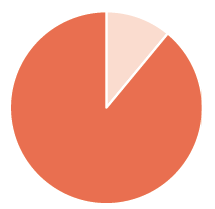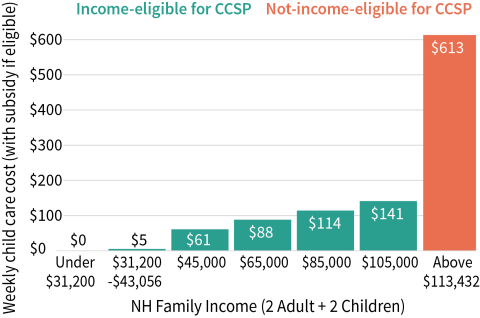download the primer
Key Findings

Around 55,000 New Hampshire children under age 13 are estimated to be eligible for the recently expanded New Hampshire Child Care Scholarship Program (CCSP).

In fall 2024, 4,348 children were enrolled in the CCSP, about 7 to 8 percent of those who are eligible, although this number has been steadily rising.

About 89 percent of children enrolled in the CCSP are connected to a child care provider and utilize their scholarship.

The Carsey School of Public Policy’s Granite Guide to Early Childhood series highlights issues surrounding early care and education in New Hampshire by synthesizing evidence on a set of interconnected topics. This primer focuses on New Hampshire’s Child Care Scholarship Program. For more detail about the series, including its other featured topics, visit this link.
Expanding New Hampshire’s Child Care Scholarship Eligibility
Child care costs are a significant expense for New Hampshire families—one that most families pay out of pocket. The federal- and state-funded New Hampshire Child Care Scholarship Program (CCSP) historically only provided payment assistance for low-income families. However, recent policy changes expanded program eligibility to include families earning up to 85 percent of the state median income (SMI): $113,432 for a family of four.
For participating families, the state sets a weekly family “cost share,” or a maximum amount that the state expects families to contribute to child care each week. Families with the lowest incomes pay $0, while those just above the federal poverty guidelines (FPG) pay $5. For those with incomes between 138% of FPG (about $43,000 per year for a family of four) and 85% of SMI, cost shares are capped at 7% of income—the U.S. Department of Health and Human Services-designated affordability threshold. Although this represents the “best case scenario” for families (see “Provider Dilemma” below), capping family contributions represents significant savings over paying out of pocket (see Figure 1).
How Does the CCSP Work?
Families who meet income cutoffs and other program rules (which include participating in work or work-promoting activity) are eligible for assistance. Once enrolled, families can identify a provider who will accept CCSP payments through the state’s child care search portal. Child care providers can choose whether to participate in the CCSP; about 70 percent of the state’s licensed providers do.1
Participating providers are paid via reimbursement, which is capped at a set weekly amount called the “Maximum Weekly Standard Rate” (“the maximum”), defined by setting type, age, and the child’s full-, half-, or part-time enrollment status. The federal government allows providers to receive the maximum even if it exceeds their tuition amount, but New Hampshire does not utilize this flexibility. To receive reimbursement, providers first bill families for their cost share and then bill the state for the difference between the family’s cost share and the maximum or the tuition rate, whichever is lower.

Source: Eligibility thresholds and cost share information via NH Department of Health and Human Services. Weekly costs for non-eligible families are derived via data from Child Care Aware 2024.2
Estimated Reach of the Scholarship Program
In New Hampshire, an estimated 55,000 children under age 13 are eligible to participate in the CCSP;3 as of October 2024, 4,348 were enrolled. Enrollment has steadily increased since program eligibility requirements expanded in 2024, growing by 21 percent between January and June 2024. Program utilization is high among enrollees, 89 percent of whom are connected to a child care provider and using their scholarship.4
However, the CCSP remains underutilized among eligible families. This seems in part due to a lack of awareness. For instance, three New Hampshire Preschool Development Grant (PDG) surveys between 2019 and 2022 found that between one-third and one-half of families had heard of the CCSP. PDG work from 2020 to 2021 also found that families experience administrative barriers like substantial paperwork and complicated application processes when trying to access the program, and that maintaining eligibility is complex amid fluctuating income.
Provider Dilemma: When Scholarships Fall Short
As providers are reimbursed a set amount for scholarship enrollees, that amount may be less than providers charge. In these cases, providers can bill families for the difference, known as a “co-pay.” There is some evidence that providers try to avoid co-pays, forgoing the revenue to avoid burdening their lowest income families. Recent changes to the NH CCSP help, increasing providers’ revenue by raising maximum reimbursements and allowing providers to bill based on children’s enrollment rather than attendance. Although these changes don’t address the systemic challenges fostering the sector’s “fragile economics,” they are important interim steps to preserve available supply.
Expanding Reach and Efficacy
Despite CCSP improvements, additional efforts could expand the program’s reach and utility further. Continued targeted outreach with trusted community partners and reducing administrative barriers could help increase family enrollment. For providers, bringing reimbursement rates closer to the true cost of care would provide critical revenue to support underpaid early educators. As one of the only existing mechanisms for directing funds to families and providers, the CCSP remains an essential lever for supporting a robust early care and education system.
About the Authors
Harshita Sarup is a research scientist II at the Center for Social Policy in Practice at UNH’s Carsey School of Public Policy.
Jess Carson is the director of the Center for Social Policy in Practice and a research assistant professor at UNH’s Carsey School of Public Policy.
Acknowledgments
This series was made possible through generous funding and partnership from the Couch Family Foundation.5
© 2024. University of New Hampshire. All rights reserved.
